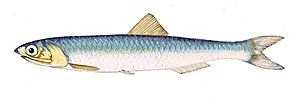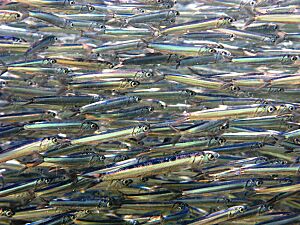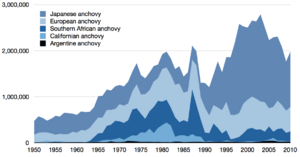European anchovy facts for kids
Quick facts for kids European anchovy |
|
|---|---|
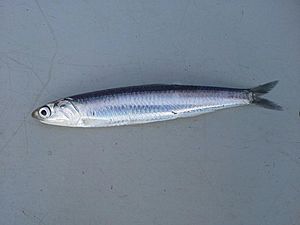 |
|
| Conservation status | |
| Scientific classification |
The European anchovy (Engraulis encrasicolus) is a small forage fish. It is a type of anchovy, a fish family called Engraulidae. These fish live along the coasts of Europe and Africa. You can find them in the Mediterranean Sea, the Black Sea, and the Sea of Azov. People catch them for food in many of these areas.
Contents
What's in a Name?
People have been catching and eating this fish for thousands of years. They could even catch them from the shore using simple tools like beach seines. The names "engraulis" and "encrasicolus" come from Ancient Greek. These were common names for this fish long ago.
How to Spot a European Anchovy
It's easy to tell this fish apart by its mouth. Its mouth opens very wide, and the corner of its mouth is behind its eyes. The pointed snout sticks out past its lower jaw.
This fish looks a bit like a sprat. It has a forked tail and one fin on its back (a single dorsal fin). But its body is round and thin. The longest European anchovy ever found was about 20.6 centimeters (8.1 inches) long. Most are around 13.5 centimeters (5.3 inches). It has a silver belly and a blue, green, or gray back and sides. A silver stripe runs along its side, but it fades as the fish gets older.
Where They Live and What They Eat
The European anchovy lives near the coast in open water. In summer, they usually stay in water less than 50 meters (164 feet) deep. In winter, they might go deeper, up to 200 meters (656 feet) in the Mediterranean. They can even go as deep as 400 meters (1,312 feet).
These fish can live in water with different salt levels. This means they can be found in salty seawater, but also in slightly salty water. You might find them in lagoons, estuaries (where rivers meet the sea), and even some lakes.
European anchovies mostly eat tiny ocean creatures called plankton. This includes small crustaceans called copepods. They also eat the eggs and young of other fish, molluscs, and barnacles.
These fish travel a lot. They often move north in summer and south in winter. They swim together in huge groups called schools. When they feel threatened, they can form a tight ball, called a bait ball, to protect themselves. Many other fish, birds, and marine mammals eat European anchovies.
Life Cycle and Reproduction
European anchovies lay eggs many times during warm periods. This usually happens from April to November, depending on how warm the water is. Some groups of anchovies have their own special places to lay eggs. These groups are different from each other. Some even lay eggs in fresh water.
Their eggs are shaped like an oval. The eggs float in the top 50 meters (164 feet) of the water. They hatch in about 24 to 65 hours. The baby anchovies, called larvae, are clear and grow very fast. If they survive for a year, they will be about 9 to 10 centimeters (3.5 to 3.9 inches) long. Female anchovies grow larger than males. They start laying their own eggs when they reach about 12 to 13 centimeters (4.7 to 5.1 inches) long. Most European anchovies don't live longer than three years.
Where European Anchovies Are Found
Across Europe
European anchovies are very common in the Mediterranean Sea. They used to be very common in the Black Sea and Sea of Azov too. Countries like Bulgaria, Croatia, France, Greece, Italy, Spain, and Turkey regularly catch them.
Their range also goes along the Atlantic coast of Europe, reaching as far north as southern Norway. In winter, they are found off the coasts of Devon and Cornwall in the United Kingdom. However, they are not usually caught in large numbers there for business.
Zuiderzee and English Channel
Long ago, many anchovies were caught off the coast of the Netherlands in summer. They would swim into the Wadden Sea and the Zuiderzee. Even after the Zuiderzee was closed off, they were still found in the Wadden Sea until the 1960s. They were also caught in the Scheldt river's mouth.
Scientists believe that anchovies found in the western English Channel in late autumn might have come from the Zuiderzee. They probably returned there in the spring. This is because the shallow waters off the Dutch coast get warmer in summer. This helps the anchovies lay their eggs and grow better.
Dutch scientists were the first to study how anchovies reproduce there. They lay eggs in June and July. The eggs float and are clear, like most fish eggs. But they are unusual because they are shaped like a sausage. The baby anchovies hatch a few days later. In August, young anchovies about 3.8 to 8.9 centimeters (1.5 to 3.5 inches) long are found in the Zuiderzee.
Mediterranean, Black Sea and Azov Sea
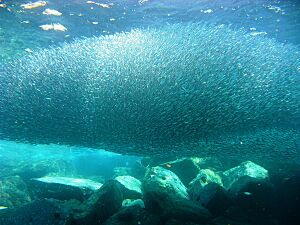
In areas around the Black Sea, the European anchovy has many local names. For example, it's called hamsi in Turkish and hamsiya in Bulgarian. Its ancient Greek name was aphýē. This name later led to the Italian word acciuga and the Croatian word inćun.
Adult anchovies in the Black Sea can grow to about 12 to 15 centimeters (4.7 to 5.9 inches). In summer, hamsi travel north to the warm, shallow waters of the Azov Sea to eat and lay eggs. They return to deeper waters for winter. During these travels, they swim in huge schools. Gulls and dolphins actively hunt them.
Hamsi are a big part of the fishing and fish processing businesses. They are sold in cans or frozen. In Turkey, it's a very popular food in the Black Sea region. People use it in many dishes, even desserts! In Bulgaria, fried hamsiya is a traditional fast food, often served with beer.
In the 1980s, anchovy numbers in the Mediterranean dropped a lot. This was because of an invasive species called Mnemiopsis leidyi, a type of jellyfish that eats anchovy eggs and young fish. The anchovy numbers have since become stable, but at a much lower level.
Off Africa
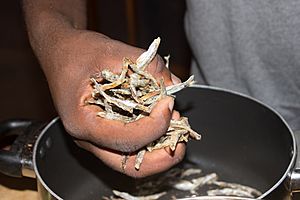
European anchovies are also important for fishing along the west coast of Africa. They are most common in the northern part of this area, especially in Morocco. In some countries like Mauritania, local fishers don't usually catch them.
In West Africa, these anchovies are widely caught and eaten. They are an important fish in Nigeria, Ghana, and Benin. When the season for other fish like Sardinella ends, fishers change their nets to catch anchovies.
South of the Angola/Namibia border, the European anchovy mixes with another type of anchovy, the South African anchovy. In Namibia, the fishing industry uses anchovies to make fishmeal and fish oil. European anchovies are also found in areas off the east coast of Africa where deep, cold water rises to the surface.
Fishing for Anchovies
The IUCN (a group that studies nature) says that European anchovy populations are healthy. However, they are fully fished, meaning people catch a lot of them. They need to be carefully watched. There isn't one big plan to manage fishing for this species across all countries.
The number of anchovies in local areas changes a lot. These changes are not fully understood. Some drops in numbers have been due to environmental problems or too much fishing in one area. Invasive species, like the Mnemiopsis leidyi jellyfish, which eats anchovy eggs, have also caused problems. Some changes in numbers are likely due to climate change.
European anchovies are caught using different types of nets. These include purse seines, lamparas, trawls, and beach seines. It is thought that not many other fish are accidentally caught when fishing for anchovies, but more information is needed.
How People Use Anchovies
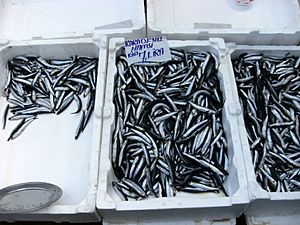
European anchovies are eaten all over the world. They are considered an oily fish and have a strong, salty taste. Some people even eat them raw.
You can buy European anchovies in many ways. They are sold fresh, dried, smoked, or salted. You can also find them packed in oil, frozen, or in cans. They are also processed into fishmeal and fish oil. Because they are easy to preserve, they have been traded over long distances for a very long time. Anchovies are also used as fishing bait to catch other fish.
See also
 In Spanish: Boquerón para niños
In Spanish: Boquerón para niños
- Anchovies as food



